The price of copper has long been seen to correspond to the development of industry and infrastructure, because the metal is required for important steps in the creation of electrical power systems and the components of heavy industry. This prompts analysts to use it as a leading indicator of economic activity and stock markets. Even so, as with any commodity, the market for copper obeys its wn logic of speculation and extremes of price into overbought and oversold territory. We believe the copper market is offering signals about where price will go during the next two years and what the surrounding economy is likely to do during the same period. This sets us up for a potential trade in the metal itself, and it also may provide evidence to confirm or contradict our overall bearish view of equity markets.
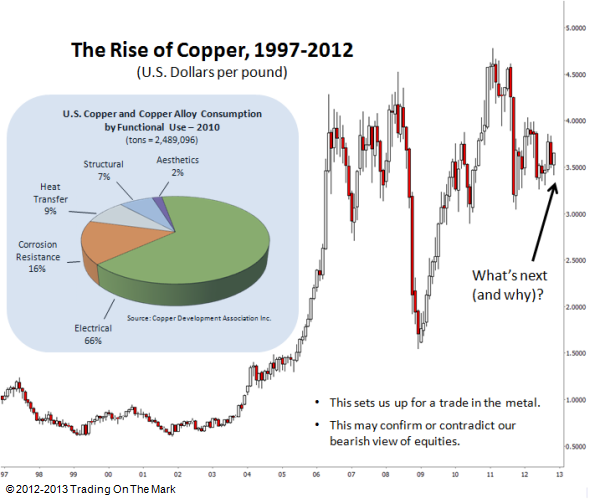
?
It?s debatable whether copper price is a leading indicator of stock markets and economic activity, but it is at least a concurrent indicator. The chart below shows how, during the last 16 years, price has risen and fluctuated in conjunction with GDP statistics for key economic regions.
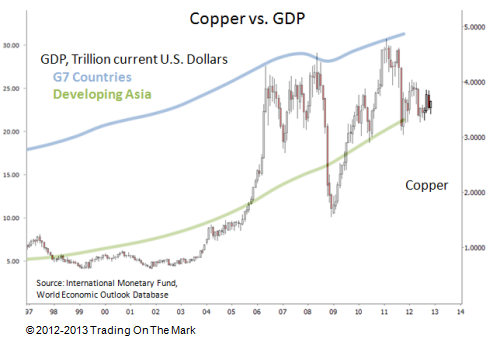
?
Also during the last 16 years, large swings in copper?s price have often (but not always) presaged swings in stock markets. The growing divergence between copper, which is currently going sideways, and the S&P 500 index, which has been going up in 2012, suggests something needs to change to bring the two back in alignment.
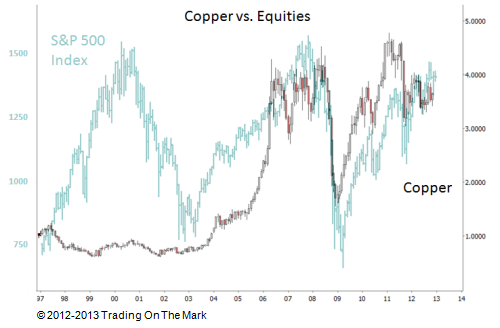
?
Why Copper Price Should Decline
Certainly one can make a case that copper is overpriced this year based on fundamental considerations. Worldwide and particularly in Asia, demand for copper appears to be slowing, while stockpiles are increasing. Since 2008, China has been the single greatest user of refined copper among all nations, until recently accounting for almost 40% of global use [1]. However, Chinese consumption of the metal in 2012 is believed to have dropped by almost 9% from the previous year, reflecting a likely slowdown in industrial and infrastructure development there [2]. Does this foretell a minor pullback in the price of the metal or a more substantial disturbance in overall economic activity? Based on what we know so far, seeing price go down or continue sideways seems more likely than seeing it climb higher.
However, unless you are at the helm of a hedge fund with large coffers, trading based on fundamentals requires a mastery and patience that few have. It helps to turn to technical considerations to find the dates and price levels that might represent turning points. We believe the copper chart reveals some of the answers about where price is going, and when it will start to go there.

?
Even though the price of copper rose impressively from 2009 to early 2011 and made a new high, the move was almost certainly corrective, as revealed by its clear three-wave structure. Also, in late 2011, price overlapped the area of the first wave (labeled ?A?), thus ruling out the possibility that a 5-wave impulsive move was forming in the upward direction. According to Elliott Wave conventions, the only way price could increase very much from the present level would be in another upward corrective leg, producing a larger complex corrective pattern of which the 2009-2011 move was just the first part. However, the 2011 high was already so far beyond the previous high of 2008 that an extended correction upward is unlikely. Besides, a corrective move rarely pushes into uncharted price territory for very long.
While a renewed push upward is unlikely, so is continued sideways action. The envelope of price extremes has been converging since late 2011, suggesting that some kind of breakout move is needed.
The alternative is that price is in the process of tracing some net-downward corrective pattern after the 2011 high. If that is the case, then the downward move should be similar in magnitude to the downward move in 2008 and the upward move that lasted from 2009 to 2011. Based on the size of the down move so far, it doesn?t look complete. Therein lies the potential trade in copper as well as the signal about larger economic activity. But when might copper resume its downward move, and from where? Should we wait for a better retrace? More clues come from a closer examination from an Elliott Wave perspective.

?
After the high of early 2011, price headed downward in what looks like another three-wave move, which we have labeled the ?A? wave. Price then went into a consolidation pattern with converging range ? something that looks very much like a classic Elliott Wave triangle. If it really is a triangle, then price should continue downward in wave ?C? after the triangle is complete.
Note, it is very important to think of this analysis as describing a potential trade or a potential move in price. Price fluctuations in any market result from the very facts that trading is difficult and that predictions of price moves are far from certain. Thus, when you identify a potential trade setup, as we are doing here, it is equally important to identify the market signals that will tell you when your expectations are wrong. Even without considering technical analysis of the charts, one warning sign would be any significant improvement in economic indicators reflecting industrial and infrastructure development, especially in China and developing Asian nations. We will mention another possible warning signal in the next section of this article.
?
Where the Decline Should Start
Next, we can do some tests to see whether the hypothetical triangle is behaving as a triangle should. Typically a triangle consists of five moves, which we label with the letters ?a? through ?e?. Each leg of the triangle is usually smaller than the one preceding it, and the ideal proportion of each leg to the previous one is somewhere between 61.8% and 78.6%. (Another common retracement value is 76.4%, which is very close to 78.6%.) So far, each leg of the hypothetical triangle in copper has ended somewhere close to the 78.6% retracement of the previous leg ? a nearly ideal triangle pattern. All of the retracement percentages mentioned here are based on Fibonacci ratios.

?
Each leg of the triangle should consist of three smaller moves, although they do not all have to be of the same size. On inspection, each of the first three legs (?a?, ?b?, and ?c?) of the triangle appears to consist of three smaller moves. We think leg ?d? also consists of three smaller moves, although it is difficult to see on a weekly candle chart. That leaves us with wave ?e?, which doesn?t yet look as though it has completed three smaller moves. Wave ?e? also has not yet reached the same retracement values that the previous waves achieved, although it wouldn?t break any rules for wave ?e? to be shorter than the others. In fact, ?e? waves of triangles are sometimes quite difficult to predict. They can extend farther than expected, or they can stop short of the target. In this case, the ?e? wave might already be finished, or it might need to complete one more leg up into one of the higher retracement values shown on the chart.
Wave ?e? of the triangle has already reached the 61.8% retrace at price level 3.686. If it continues onward, the price targets at the 76.4% and 78.6% retracement levels are 3.749 and 3.758 respectively. It could also push a little bit higher than that, as long as it doesn?t go higher than the top of wave ?c?. A clear sign of the triangle idea being wrong would come from price exceeding the high labeled as ?c? of the triangle (at 3.8525 based on continuous contract futures price data). If that were to happen, then the whole Elliott Wave pattern and trade setup should be reevaluated.
?
When the Decline Should Begin
It is also possible to predict the most likely dates for the final ?e? wave of the triangle to end. Counting the number of weeks between turns, we see that 35 weeks elapsed from the week when the triangle began to the week when wave ?b? reached its lowest point. Measuring the time between the next lows, 22 weeks elapsed between the ?b? wave low and the ?d? wave low. The ratio of 22 to 35 is 63%, which is close to the ideal 61.8% relationship.
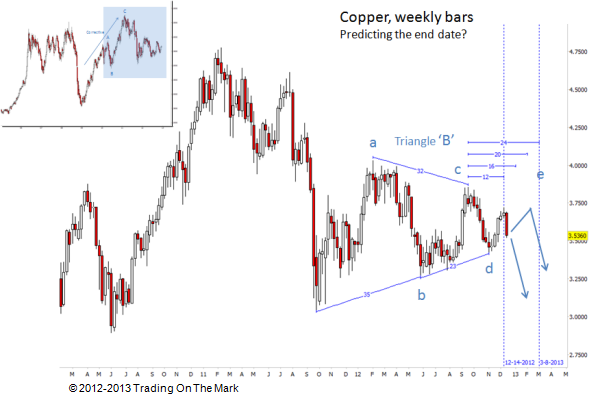
?
If we apply the same principle to the high points of the triangle, wave ?e? should complete sometime near the date that represents 61.8% of the 32 weeks that elapsed between high ?a? and high ?c?. That would put the completion of wave ?e? around the week ending February 8, 2013. Another common time ratio is 75%, which would put the end date closer to the week ending March 8. We might consider that a ?longest case? scenario for wave ?e?.? To solve for some of the earliest possible times for a turn, we can use 38.2% and 50% which result in possible turns around the weeks of December 14th and January 11th.
?
How Far the Decline Should Extend
If the triangle idea works, how far should the next downward move extend? Again, Fibonacci ratios are very handy in calculating the most likely price targets. Wave ?C? should be measured starting wherever the final wave ?e? of the triangle ends. In the chart below, we assume wave ?e? will end at the 3.749 price level, although that is yet uncertain.
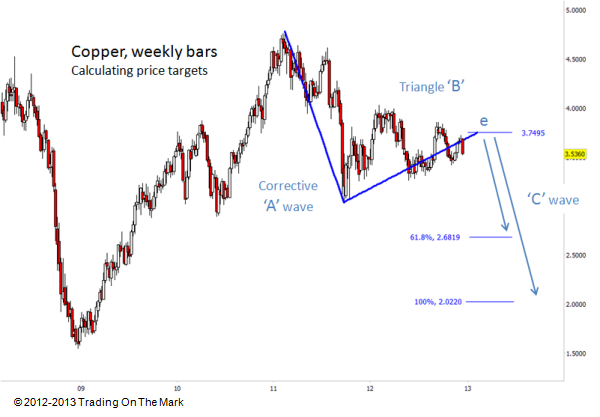
?
Using the end of wave ?e? as the starting point, it is common for the ?C? wave coming out of a triangle to extend either 61.8% as far as the ?A? wave that preceded the triangle, or to extend a distance equal to the earlier ?A? wave (i.e. 100% of it). If the ideal scenario plays out in copper, the most likely downward price targets would be near 2.6819 and 2.0220.
Because it is very clear where our scenario would be invalidated (if the supposed wave ?e? of the triangle goes higher than wave ?c?), our risk in entering a trade in the metal are clearly defined and relatively small compared to the potential reward. Also, as we indicated earlier, the success of the trade may also confirm other expectations for stocks and currencies. A thrust down in copper, when and if it occurs, will likely be accompanied by weakness in many stock indices worldwide and will probably also coincide with renewed strength in the U.S. Dollar.
?
?
About Trading
If this is the kind of trading information that you can use, consider exploring?Trading On The Mark ?with a month-long discounted trial membership.? A trial membership gives you full access to our analysis of stock indices, currencies and commodities on timeframes ranging from months to minutes. It also opens the door for you to join in our live trading room where we identify intraday trading opportunities. Trading On The Mark is a source of guidance and a place where you can have your questions answered by experienced traders, and that may be the key to developing a successful trading plan for yourself.
Trading futures and options involves the risk of loss and is not suitable for all investors. Technical analysis, such as what is presented in this article, is not a guarantee of future outcomes. Nothing in this article should be construed as a recommendation to buy or sell financial instruments.
devil inside dash diet how to make moonshine joel osteen emmy rossum jay z and beyonce the big chill
Hi, what a great web blog. I usually spend hours on the net reading blogsBusiness Event Management.And, I really would like to praise you for writing such a fabulous article. This is really informative and I will for sure refer my friends the same. Thanks
উত্তরমুছুন